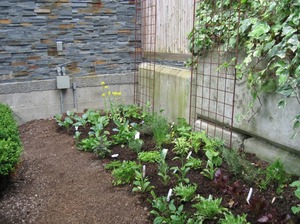Diversity, Stability and Resilience
Dear Friends
It’s Spring and nature is in full bloom here in the Northwest. Not that these two lovers to the right are from here, they aren’t. They’re from latitudes far to the south where it is perpetually Spring or Summer. Any guesses what they are, and where they’re from? If you can give me their common name, genus and species, and specifically where this wild breeding pair calls home, I’ll gift you one Therapeutic Foods products of your choice.

At any rate our modest little condo garden is planted and taking hold, as you can see; with the agreement, amongst our fellow condo dwellers, that next year we will create a raised bed garden, in the tradition of the French Intensive Method. This will greatly raise our garden’s level of productivity.
I’ve personally experienced the magic of Biodynamic/French Intensive Farming from the master himself- Alan Chadwick, the man who brought this method to American in the 70’s from France (see the link above).
The skin of the Earth must be approached with great sensitivity. It is alive and it contains a spirit. It is easily bruised or damaged. In some respects, it is even more delicate than the bloom on the surface of a plum. Approach it without sensitivity, or at the wrong time, and you will damage it- Alan Chadwick
This brings me to the point of this week’s newsletter. How is the microbiome of the human gut like a garden? How do principles for creating a healthy productive garden apply to creating a healthy gastrointestinal environment? I will focus on ideas posited in Catherine Lozupone et al’s research paper published in Nature Sept 13, 2012, entitled Diversity, stability and resilience of the human gut microbiotia.
For starters, both are ecosystems, and therefore applying sound ecosystem principles that makes for a healthy, productive, resilient ecological community will benefit both your garden and your gut. Let’s look briefly at two: diversity and redundancy.
- Diversity
When we look at gardening it has become increasingly clear that having a diversity of species woven intelligently into a garden plot creates a hardy, resilient ecosystem and eliminates the need for herbicides and pesticides to protect against pathogens. This has been repeatedly proven through gardening technologies such as those employed by eco-agriculture, permaculture, biodynamic, and organic farming.Regarding diversity in the human gastrointestinal tract, we are referring to an ecosystem within a healthy gut of around 100 trillion microbes representing approximately 1000 species—a diversity of beneficial enterotypes providing important GI tract functions. As an example, let’s take the capacity of a good bug to colonize the GI tract membrane, thereby protecting it from invasive pathogens. Having multiple beneficial organisms able to protect the mucous membrane in this way enables the function to be maintained if one is wiped out by a phage attack or an antibiotic. Resilience of functionality is maintained. - Redundancy
“To date, the most powerful studies tend to combine SSU rRNA profiling to determine taxon abundance (the microbiota) with shotgun metagenomic probing to understand the functions present (the microbiome).” What has become very clear is that redundancy of functionality is of utmost importance. That there are multiple good guy organisms capable of producing the same enzymes enables the ecosystem of the gut to maintain functional resilience in the face of pathogenic challenges.
Praise must be given to the advances in technology made possible through the Human Microbiome Project and Meta HIT. These analytical tools have made it posssible for us to focus on communities as a whole rather than just focusing on individual bacteria. We are beginning to see the forest from the trees.
Sincerely yours,
Seann Bardell
Clinical Note:
Probiotics and Polyphenols are receiving today much research interest within the scientific community for their health giving properties. At BioImmersion we believe that providing a diversity of these items in our diet on a daily basis is very important towards attaining robust health.
Why not try the following on a regular basis for three months and see how your body responds:
Energy Sustain (one scoop a day), Phyto Power (2 caps a day), Organic Chlorella (4 tabs a day), Wild Blueberry Extract (1 cap a day), Ultra Minerals (4 caps a day), Cruciferous Sprouts (2 caps a day), Fructo Borate (two caps a day), Organic Garlic (1 cap per day) Supernatant Synbiotic (1 cap per day), Beta Glucan (1 tbl. per day).
Let me know what your experience.
The Last Quiz Answer:
This great fisher is the tall, long-legged great blue heron. It is the most common and largest of North American herons. Their average life span is 15 years. They can be over 4 feet tall with a wing span of 6 feet. They can fly effortlessly at 20 to 30 miles per hour. Though they are best known as fishers, mice constitute a large part of their diet. They also eat insects.


The Environmental Working Group makes it very easy for us to take action politically. The senate will start voting in just a few days on the 2013 farm bill subsidies.
Provisions tying crop insurance subsides to sustainable farming practices are included in the farm bill. Healhty food comes from healthy land, and we need you right now to tell your senators to support these provisions and other healthy farming amendments.
Click here to take action today.